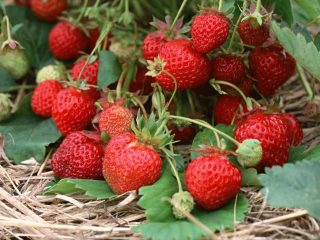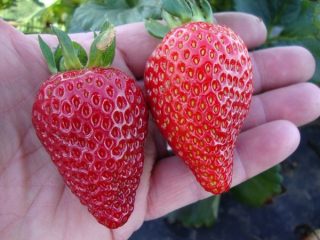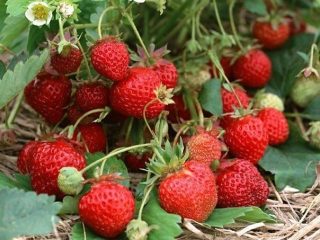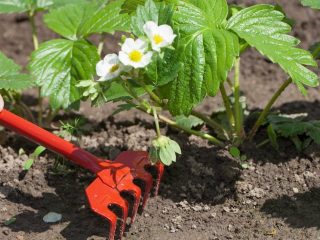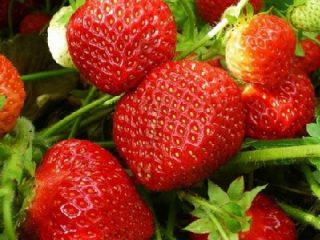Content
It is easiest to distinguish between male and female strawberry bushes at the stage of flower blooming and ovary formation. However, this does not mean that a novice gardener will have to wait for the flowering period. It is also possible to determine the sex of young plants.
Are there male and female strawberry bushes?
The situation when strong and healthy strawberries do not bear fruit is well known to many gardeners. You should not immediately blame the seller for supplying defective seedlings. Perhaps there are simply too many “male” specimens planted on the site. This is why it is so important to be able to distinguish plants of different sexes.
However, from a scientific point of view, there is no division into “male” and “female” varieties. Strawberries are a monoecious crop with bisexual flowers. The main difference is related to the process of formation of whiskers on rosettes.
Garden strawberries, growing in the middle zone, form the very first tendrils in the last ten days of May. In the southern regions this happens three to four weeks earlier. The first and second rosettes are precisely the “female” seedlings.After two months, you can observe at least five leaves and a central bud with a diameter of 1-1.5 cm. The rosette itself takes on a flattened, slightly rounded shape.
Active setting of peduncles is associated with weak reproduction capabilities by throwing out tendrils. Most often, the habitat of the “girls” expands due to the transfer of seeds and berries by birds.
The third and subsequent rosettes are “boys”. Their reproduction occurs mainly with the help of whiskers. They can be distinguished mainly by external signs.
By the time of flowering, they have three or four leaves and a core with a diameter of no more than 5 mm. The formed rosette has a conical, slightly elongated shape. “Male” specimens do not form ovaries, but conquer space by actively throwing out their whiskers.
Although scientists deny the presence of heterosexual bushes, from an economic point of view, it is easier for gardeners to distinguish strawberries precisely by this characteristic.
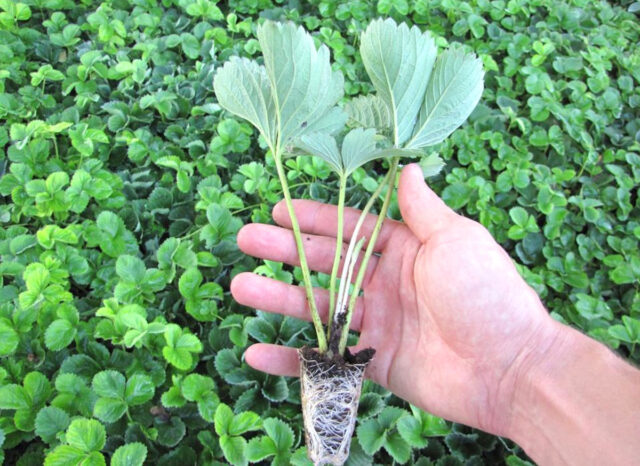
The ability to determine “sex” will be useful when buying seedlings in a store
As for the reason why the “sex” of strawberries is determined, it is simple – increasing and controlling the crop’s yield.
Is it possible to distinguish male strawberries from female ones?
It is not only possible, but also necessary to be able to distinguish “female” strawberry plants from “male” ones. The general population of “boys” will negatively affect the yield, while outwardly the garden bed will look excellent.
To determine whether it belongs to a certain group, the gardener needs to evaluate the foliage of the bush, the color of the plates, size, number of rosettes and their shape.It is easiest to distinguish “male” bushes from “female” ones during the flowering period of the crop.
When purchasing young seedlings, you can focus on the size of the mustache. Large modified shoots are most often a sign of “boys”. On “female” bushes the mustache can be observed only after the first fruiting.
What are male strawberry bushes for?
Despite self-pollination, without “male” specimens, strawberries will bear less fruit. However, this does not mean that you should actively encourage the reproduction of “boys”. The optimal ratio, according to practical observations, is a proportion of 10 to 1, where 10 are “female” specimens, and 1 is a weed variety.
We remind you that the male strawberry bush differs from the female one primarily in the presence of barren flowers, that is, it is absolutely useless as a fruit-bearing crop. Moreover, this is not its only drawback.
The main disadvantages of weeds:
- “Male” bushes take up space that can be used for planting productive varieties.
- Barren flowers draw nutrients and water from the soil necessary for “working” strawberries.
- A large number of “male” plants leads to thickening of plantings and, as a result, the berries become smaller.
Thickening can lead to poor air circulation, which in turn can lead to disease or pest damage.
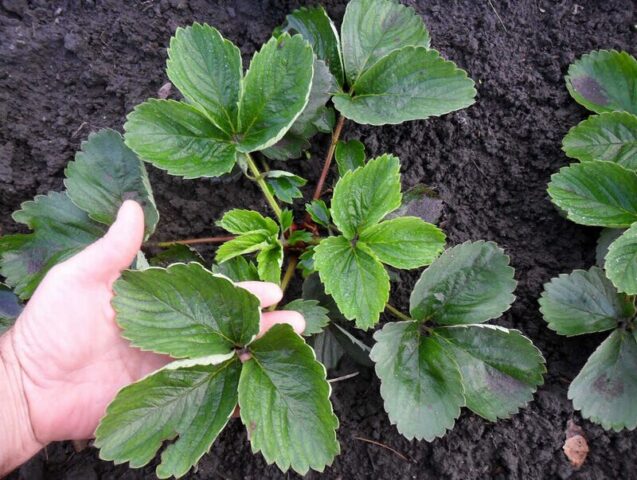
One “male” bush can pollinate up to ten “female” ones.
Therefore, it is so important to control the number of “male” plants in the garden plot and be able to distinguish them from “female” specimens.
How does the sex of bushes affect yield?
Even if the “boys” are completely removed from the garden, varietal strawberries will bear fruit. However, the crop yield will be significantly lower.
“Male” bushes increase pollination, but their dominance will cause a reverse reaction. Varietal plantings will begin to wither, and the quality of the berries will deteriorate. That is why gardeners remove excess barren flowers from the garden bed. However, before you begin thinning, you need to understand the differences between “male” and “female” strawberry bushes. Having sorted it out, you can start removing the clogs.
To begin with, the “male” plants are manually removed from the soil. They do this with careful movements, twisting each bush from the soil. It is not recommended to pull out the bush with a sudden movement. This can damage the roots of both the plant itself and neighboring plantings.
As a result of removing the strawberries, you can observe the resulting holes in the garden bed. They are filled with soil to the general level and, if necessary, neighboring plants are watered. There is no need to fertilize anything.
Removed “male” specimens should not be thrown away immediately. The fact is that even they are capable of producing completely healthy and full-fledged “female” offspring. In addition, novice gardeners sometimes make mistakes when thinning and remove the “girls,” so after removing the plantings, it would not be superfluous to inspect them again to determine their sex.
As for the “male” strawberry bushes, they can be planted in a separate bed. The future landing site is prepared in advance. The soil is first dug up and fertilized by adding old manure or compost. In the absence of organic matter, it can be replaced with multicomponent mineral fertilizers.
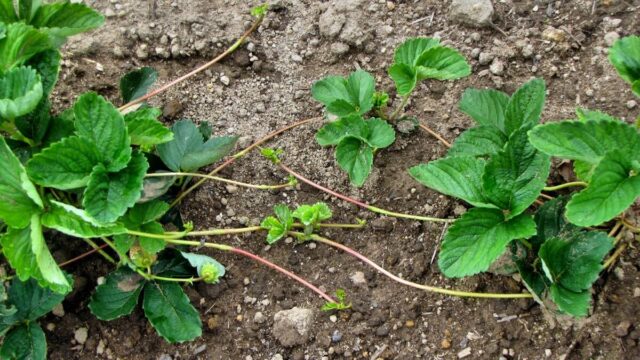
The first and second rosettes of a strawberry bush are usually “female”
It must be remembered that garden strawberries are often attacked by pests, and at the time of transplantation they are most vulnerable, so it would not be superfluous to treat the soil with Dursban, Nurell or biologically active agents.
Having identified the differences, the “male” plants are replanted, keeping a distance of 10-15 cm between the bushes. Such close proximity does not allow active throwing out of the mustache, as a result of which a switch to the formation of peduncles occurs.
The mustaches thrown out in the garden should be trimmed with pruners or scissors. If we are talking about a valuable variety, then it is quite possible to leave a couple of shoots.
Transplantation is carried out at the end of August or at the beginning of September. Strawberries need at least a month for the crop to adapt before the first frost.
With properly carried out agrotechnical measures next year, strawberries will form high-quality peduncles and give an excellent harvest.
How to distinguish male and female strawberry bushes
It is difficult to distinguish a male strawberry from a female strawberry from a photo, primarily because the photograph does not always convey the external characteristics of the bush. Namely, it is easiest to determine the gender by “exterior”.
How to distinguish male and female strawberry mustaches
Beginners often come to a dead end when they learn about the need to thin out and remove the “boys” from the garden bed. In fact, recognizing “male” strawberry bushes is not that difficult.
Barren flowers are much larger and more powerful than their neighbors in the garden. The leaf blades of the bush are distinguished by a bright emerald color, while their shade is one or two shades darker than fruit-bearing plants.The rosettes have a cone-shaped shape, while in “female” plantings it is rounded and flattened.
Weeds throw out many tendrils, on which the formation of rosettes can be observed almost immediately. “Male” bushes do not waste energy on bearing fruit.
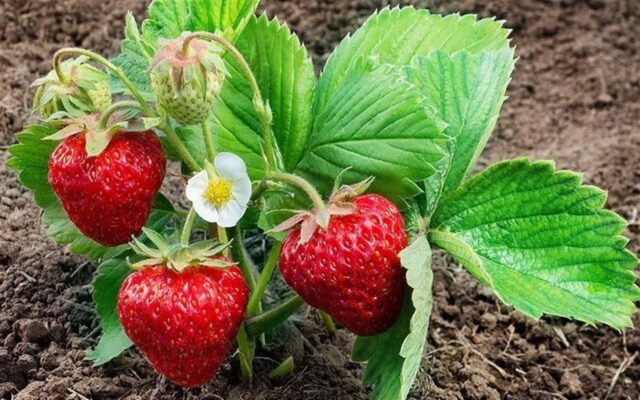
“Male” specimens can be used to propagate fertile varieties
In rare cases, these plantings bloom, and the resulting flowers are distinguished by their larger size and small number. Even less often, barren flowers delight gardeners with berries. In this case, the fruits are small, pale, and have poor tasting qualities.
Conclusion
Distinguishing between male and female strawberry bushes is not as difficult as it seems at first glance. The ability to find differences will help solve the problem of reproduction and will significantly increase crop productivity.
